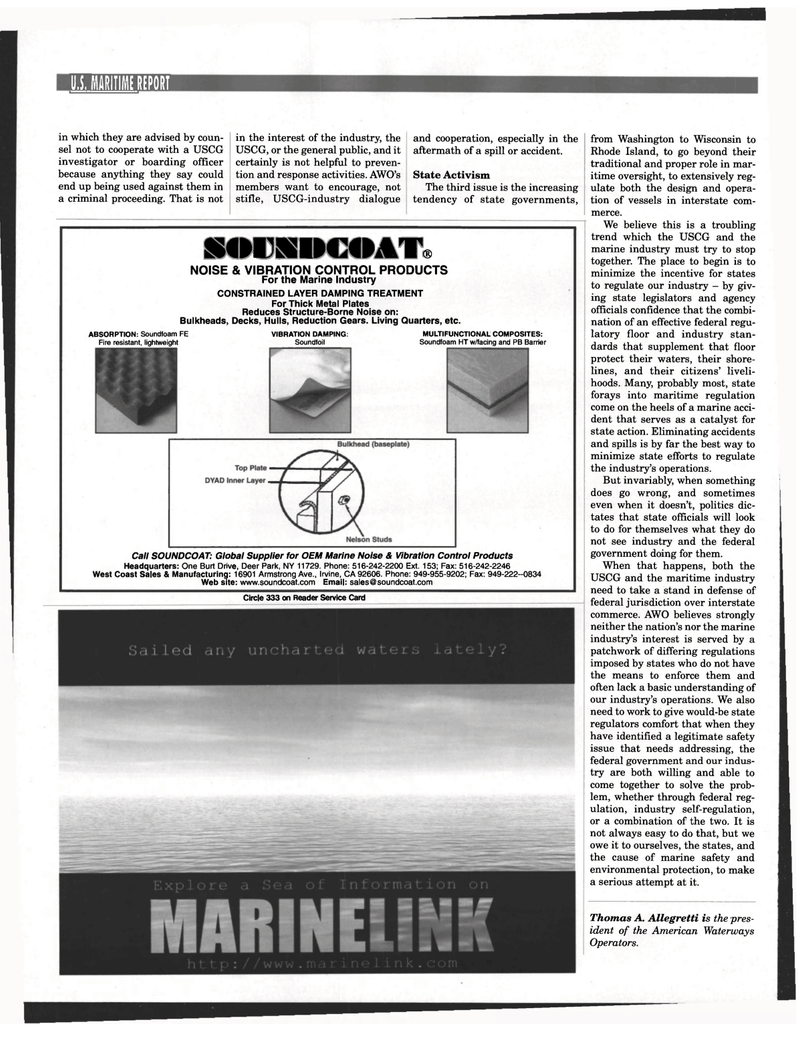
Page 78: of Maritime Reporter Magazine (October 1998)
Read this page in Pdf, Flash or Html5 edition of October 1998 Maritime Reporter Magazine
M ill REPORT in which they are advised by coun- sel not to cooperate with a USCG investigator or boarding officer because anything they say could end up being used against them in a criminal proceeding. That is not in the interest of the industry, the
USCG, or the general public, and it certainly is not helpful to preven- tion and response activities. AWO's members want to encourage, not stifle, USCG-industry dialogue and cooperation, especially in the aftermath of a spill or accident.
State Activism
The third issue is the increasing tendency of state governments,
SSOIlKIICOAf ®
NOISE & VIBRATION CONTROL PRODUCTS
For the Marine Industry
CONSTRAINED LAYER DAMPING TREATMENT
For Thick Metal Plates
Reduces Structure-Borne Noise on:
Bulkheads, Decks, Hulls, Reduction Gears. Living Quarters, etc.
ABSORPTION: Soundfoam FE VIBRATION DAMPING: MULTIFUNCTIONAL COMPOSITES:
Fire resistant, lightweight Soundfoil Soundfoam HT w/facing and PB Barrier
Call SOUNDCOAT: Global Supplier for OEM Marine Noise & Vibration Control Products
Headquarters: One Burt Drive, Deer Park, NY 11729. Phone: 516-242-2200 Ext. 153; Fax: 516-242-2246
West Coast Sales & Manufacturing: 16901 Armstrong Ave., Irvine, CA 92606. Phone: 949-955-9202; Fax: 949-222--0834
Web site: www.soundcoat.com Email: [email protected]
Circle 333 on Reader Service Card from Washington to Wisconsin to
Rhode Island, to go beyond their traditional and proper role in mar- itime oversight, to extensively reg- ulate both the design and opera- tion of vessels in interstate com- merce.
We believe this is a troubling trend which the USCG and the marine industry must try to stop together. The place to begin is to minimize the incentive for states to regulate our industry - by giv- ing state legislators and agency officials confidence that the combi- nation of an effective federal regu- latory floor and industry stan- dards that supplement that floor protect their waters, their shore- lines, and their citizens' liveli- hoods. Many, probably most, state forays into maritime regulation come on the heels of a marine acci- dent that serves as a catalyst for state action. Eliminating accidents and spills is by far the best way to minimize state efforts to regulate the industry's operations.
But invariably, when something does go wrong, and sometimes even when it doesn't, politics dic- tates that state officials will look to do for themselves what they do not see industry and the federal government doing for them.
When that happens, both the
USCG and the maritime industry need to take a stand in defense of federal jurisdiction over interstate commerce. AWO believes strongly neither the nation's nor the marine industry's interest is served by a patchwork of differing regulations imposed by states who do not have the means to enforce them and often lack a basic understanding of our industry's operations. We also need to work to give would-be state regulators comfort that when they have identified a legitimate safety issue that needs addressing, the federal government and our indus- try are both willing and able to come together to solve the prob- lem, whether through federal reg- ulation, industry self-regulation, or a combination of the two. It is not always easy to do that, but we owe it to ourselves, the states, and the cause of marine safety and environmental protection, to make a serious attempt at it.
Thomas A. Allegretti is the pres- ident of the American Waterways
Operators.

 77
77

 79
79
